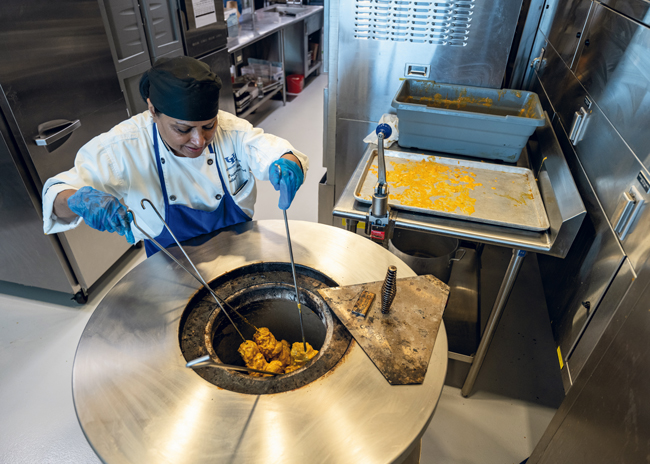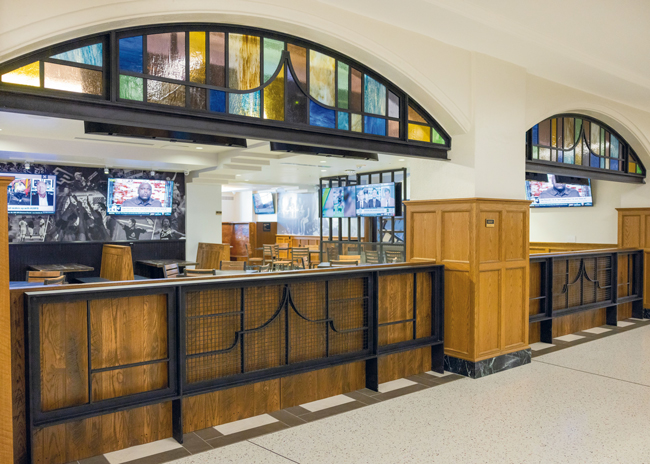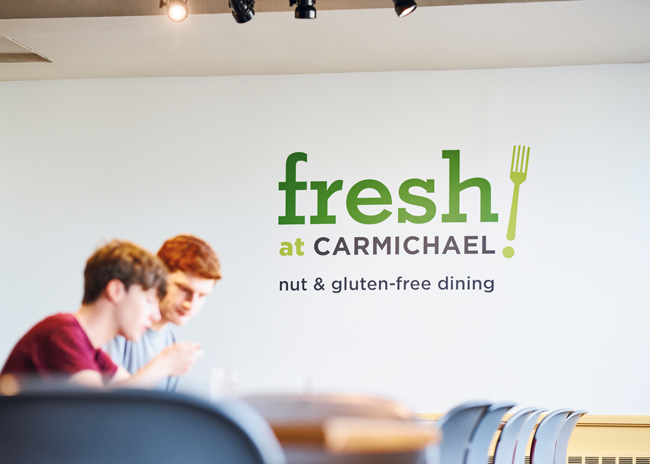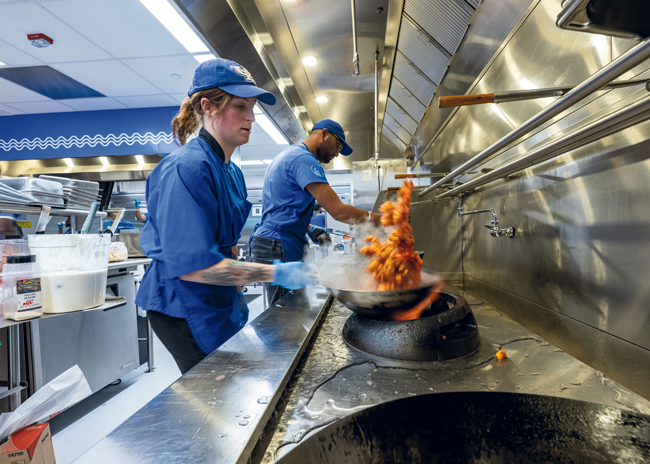Colleges continue to fine-tune dining halls and menus to cater to all their customers — including those who may have felt left out.
 Photo by Onion Studio, courtesy of University at Buffalo.Always and everywhere, it’s the most important reason that people eat together rather than alone: strengthening the feeling of community and belonging. Building community has always been a big part of the mission of college and university dining services in particular, but now the mission has been expanded with a new focus on diversity, equity and inclusion (DEI).
Photo by Onion Studio, courtesy of University at Buffalo.Always and everywhere, it’s the most important reason that people eat together rather than alone: strengthening the feeling of community and belonging. Building community has always been a big part of the mission of college and university dining services in particular, but now the mission has been expanded with a new focus on diversity, equity and inclusion (DEI).
“The role of dining environments in creating socially equitable space is at the top of all of our clients’ thinking,” says Jan van den Kieboom, architect and founder and owner of Workshop Architects, a firm that specializes in higher education.
The physical configuration of the space reflects the goal of inclusion, van den Kieboom says. “There are ways to design spaces to eliminate social barriers,” he explains. One key is to facilitate what he calls peripheral participation: “You allow people to experience a space from the edge so that they can feel comfortable before they fully commit to be part of it. You replace closed doors with permeable thresholds to make participation more inviting and less intimidating.”
Making campus dining spaces welcoming to all means thinking not only about infrastructure and food but also about interior design, says Brad Barnes, president of Pure Food Consulting. “Whether students can see themselves in the space depends in part on what kind of pictures are hung, the way text is written, what language it’s written in,” he says. “If we can find ways to be sensitive in messages and graphics in the environment, it can be very powerful. There are cues that tell people who are in the minority that they matter.”
Barnes says he was struck by a video he saw recently, in which two young Muslim women walk into a dining hall at Detroit’s Wayne State University and express astonishment at seeing a verse from the Quran on the wall. “If you’re not in the minority in that setting, you don’t know how important these cues are in showing people that they matter, that they are being considered,” he says.
 At the new Atlas Family Marketplace food hall on the ground floor of Purdue University’s Memorial Union, the design of a stained-glass window installed a century ago is repeated in a number of places, including over serving counters, as a callback to the building’s history. College and university clients’ questions about culturally sensitive design and graphics are “a very recent development,” Barnes says. But he cautions that these design decisions can’t come solely from the top. Rather, they require “a highly inclusive process. It’s important for individuals from these groups to decide what messages are important to share.”
At the new Atlas Family Marketplace food hall on the ground floor of Purdue University’s Memorial Union, the design of a stained-glass window installed a century ago is repeated in a number of places, including over serving counters, as a callback to the building’s history. College and university clients’ questions about culturally sensitive design and graphics are “a very recent development,” Barnes says. But he cautions that these design decisions can’t come solely from the top. Rather, they require “a highly inclusive process. It’s important for individuals from these groups to decide what messages are important to share.”
Sojo Alex, principal at Envision Strategies and a specialist in strategic and master planning in college and university dining facilities, says planning for diversity, equity and inclusion “plays a huge role in design and in promoting students’ mental wellness and accommodating neurodiversity.” Accommodating different needs means offering food for both dine-in and takeout, for digital preordering as well as impulse-driven grab-and-go, Alex says. It means utilizing dining spaces in a variety of ways, including some that may not involve food.
For Alex, inclusion also means selecting and training frontline foodservice staff who can relate to students and have the time to do so. For example, she says, “Miss Yolanda, the cashier in your dining hall, can be a sort of substitute for your mom or grandmom. ‘Hey, how was your exam? Are you eating well? Did you sleep well?’”
Additionally, inclusiveness means approaching food differently, “repurposing the all-you-care-to-eat model, making the process more interactive and using it to give students life experience,” Alex says. At some campuses, she says, breakfast omelets or the plate of the day come with a chef’s lesson on simple cooking skills. In addition, meals also present opportunities to teach students about nutrition.
 Old rails from local streetcars of another era became bar foot rails for Walk-On’s Sports Bistreaux at the Atlas Marketplace in Purdue University’s Memorial Union. Photos courtesy of Purdue University
Old rails from local streetcars of another era became bar foot rails for Walk-On’s Sports Bistreaux at the Atlas Marketplace in Purdue University’s Memorial Union. Photos courtesy of Purdue University
Connecting Across Town and Time
College and university campuses may sometimes seem isolated from the town around them. In addition to building a sense of community within the campus, some colleges continue to find new ways to involve the surrounding community. “Creating connections between the campus and the community is an important goal of almost all our clients,” says van den Kieboom. One way to put students, faculty and staff face-to-face with local residents is to recruit local restaurants, rather than national chains, for spots in retail food courts and other campus locations. Another, he notes, is to “create a venue to bring in different restaurateurs on different days of the week, so that one space becomes many different restaurants.” The college can change partners easily, so such an arrangement becomes far more flexible than a commitment with a national restaurant franchise, van den Kieboom points out.
Another form of making connections is by linking today’s campus community to the college’s past. One institution that has put a lot of thought into callbacks as part of a major renovation is Purdue University in West Lafayette, Ind., which overhauled its retail offerings in the Memorial Union. The 67,000-square-foot Atlas Family Marketplace, developed by Purdue and its retail food contractor Aramark with help from Workshop Architects, Cini-Little and Tipton Associates, opened in 2022. It features 11 dining venues and a convenience store.
But along with the radical modernization, Purdue also prioritized highlighting its heritage. “The Union is a 100-year-old facility that holds a lot of meaning on campus,” notes Zane Reif, senior director, Purdue Memorial Union and auxiliary services. “The Atlas Family Marketplace preserves the historic feel of the building; we are now a destination for students, faculty, staff, visitors, and the community because of the storytelling woven into each area.” Subtle callbacks in the space include repetition of the design of an original Memorial Union stained-glass window in several places, including above serving counters, as well as Purdue Boilermaker memorabilia and mural-size blowups of old sports photos at Walk-On’s Sports Bistreaux, a sports bar.
Equally important to setting a congenial mood are the facility’s social spaces: four performance stages (including one outdoors), a fireplace lounge, two outdoor seating terraces with fire pits, and areas set aside for study or collaboration. Those amenities were made possible by shrinking kitchen space. “You can wander around the ground floor, explore food options and then find a comfortable area to sit that will make you feel cozy yet still invigorated by the bustling activity going on around you,” Reif says. There’s objective proof of the appeal of the Atlas Family Marketplace: Traffic, which had averaged 4,700 visitors per day in the old food court space, has more than doubled, rising to 10,800 daily visitors during the spring 2023 semester.
Designers of other university dining remodels have reached much further into the past for inspiration. For example, the University of Maryland in College Park built its first new dining hall in almost 50 years, honored the native Piscataway tribe who have lived in the area for centuries [See full story in FE&S April 2023 Facility Design Project of the Month]. The dining hall’s name, Yahentamitsi, means “the place where you go to eat” in the Algonquin language spoken by the Piscataway.
 Seeking inclusion for allergen-sensitive students, Tufts University created Fresh at Carmichael, a residential dining hall that serves a menu entirely free of gluten, peanuts and tree nuts; halal, vegan, and vegetarian options are always available. Photos courtesy of Tufts University
Seeking inclusion for allergen-sensitive students, Tufts University created Fresh at Carmichael, a residential dining hall that serves a menu entirely free of gluten, peanuts and tree nuts; halal, vegan, and vegetarian options are always available. Photos courtesy of Tufts University
Inclusion in Food Offerings
Accommodating diverse food needs and preferences has been an issue for college and university dining services for a long time, but “it’s never been more important,” van den Kieboom says. “When we’re working on a project, we spend a lot of time interacting with students — reaching out to underrepresented students in particular. We see how much they appreciate it when there’s authentic representation of their culture in the menu.”
 For One World Café at University at Buffalo, the right equipment makes for authentic ethnic fare: an Indian-style high-heat tandoor oven at Tikka Table (photo on page 16)and woks for speed cooking at Pan Asian. Photo by Onion Studio, courtesy of University at BuffaloBarnes says college students are also thinking more deeply today about food and its origins, sustainability and integrity. He throws out typical questions: How was the beef for my burger slaughtered? Is this sustainable or regenerative agriculture? Is it humane to kill?
For One World Café at University at Buffalo, the right equipment makes for authentic ethnic fare: an Indian-style high-heat tandoor oven at Tikka Table (photo on page 16)and woks for speed cooking at Pan Asian. Photo by Onion Studio, courtesy of University at BuffaloBarnes says college students are also thinking more deeply today about food and its origins, sustainability and integrity. He throws out typical questions: How was the beef for my burger slaughtered? Is this sustainable or regenerative agriculture? Is it humane to kill?
“What is different now on many levels is managing procurement,” Barnes says. “It’s a huge challenge to do so cost-effectively. The biggest food purchasers are dealing proactively with agricultural suppliers.”
One important part of the new attention to DEI is serving those who require special diets without making them feel marginalized. Tufts University in Medford, Mass., tackled this problem with Fresh at Carmichael residential dining hall, which opened in the fall of 2021. “Our vision was to provide students with food allergies the same feelings of safety and belonging that others have when they dine on campus,” says Amy Hamilton, manager of strategic communications and marketing for Tufts Dining.
The university converted one of the two residential dining centers on campus to a gluten-, peanut-, and tree nut-free facility. Menus at Fresh at Carmichael also feature halal, vegan, and vegetarian options at every meal. Switching to the new menu with new ingredient limitations requires cooks to make almost everything from scratch; they created 190 new recipes and reworked the classics to match the new ingredient list. While transforming the menu, Tufts opted to make only minor cosmetic changes to the dining hall, including new signage.
Meanwhile, at Dewick-MacPhie (the university’s other residential dining hall), the Beans, Greens and Grains platform was relaunched as a certified kosher vegan offering, allowing students who eat kosher meals to dine alongside their peers. Also in the Dewick-MacPhie Dining Center, Tufts rolled out its ALL9FREE platform, which provides students with foods that exclude the top nine allergens.
An advisory group of students who require dietary accommodations contributed input to the design of the program in both dining halls.
The Students Speak
The University at Buffalo, the largest campus in the State University of New York (SUNY) system, developed its One World Café retail concept in 2022 in response to two issues.
The university had identified a demand for expanded gathering, dining and studying spaces for the growing North Campus population. To meet that demand, the Heart of the Campus capital project was launched a decade ago. The ongoing project [announced in 2012, started in 2014 and scheduled to be completed in 2030] features upgrades to three campus buildings, including the transformation of a library and the addition of a new academic support center. One World Café offers multitiered seating for 560 diners, fireplaces scattered throughout the dining areas, lots of natural light and outdoor seating for warm days.
The other challenge was accommodating wide-ranging dining preferences. “The University at Buffalo has one of the largest international student populations in the country,” says Ray Kohl, director of marketing and communications for Campus Dining and Shops. “It was important for us to survey students and guests on what types of foods they wanted to see at a new global marketplace.”
When students, faculty and staff were asked about their dietary preferences or limitations, a third expressed a demand for vegan fare, and almost 3 out of 10 said they wanted halal offerings. When students were queried about ethnic food preferences, the most popular cuisine named was Indian, with Far East and Southeast Asian close behind. More than half of respondents also said they’d like to see European cuisines represented.
Based on those findings, the university created five food stations: an Indian concept called Tikka Table, a Mediterranean station named Kali Orexi, The Noodle Pavilion, The 1846 Grill, dedicated to North American comfort food, and a pan-Asian area. (Tikka Table, Kali Orexi and The Noodle Pavilion all offer halal meats.) The design of the space, by CannonDesign, gave each area its own unique style.
Culinary staff make all food on-site, either exhibition-style behind the front counter or in each concept’s small back kitchen. The most specialized item of equipment is the Indian-style tandoor oven in the back kitchen of Tikka Table. Also of note is the labor-saving remote fryer setup, which fills fryers and filters oil automatically and also stores used oil in a lower level before it’s hauled away. Waste is sorted and sent to a facility where it’s processed to create electricity, and containers, napkins and tableware are fully compostable.
The university administration is impressed enough with the success of One World Café that it plans to create more locations around campus.
 Left: The University of Richmond opened a new Well-Being Center featuring the first college campus outlet of all-organic concept Organic Krush, co-founded by Richmond alumna Michelle Walrath. Photo courtesy of University of Richmond
Left: The University of Richmond opened a new Well-Being Center featuring the first college campus outlet of all-organic concept Organic Krush, co-founded by Richmond alumna Michelle Walrath. Photo courtesy of University of Richmond
Plant Forward
If there’s any dining style that’s moved from the edges to the center of the plate in college and university dining in recent years, it’s vegan or plant-based fare. In its announcement in April, Sodexo said it aims to reduce its global carbon footprint by a third over the next two years, and its internal analysis had found that animal-based foods accounted for 70% of the company’s total carbon output.
There’s a simple way to increase consumption of plant-based meals on campus, says Rob Morasco, vice president of innovation for the Sodexo Campus division: Flip the script. “Make the plant-based meal the default,” he says. Instead of going to the dining hall and specifying a stir-fry with tofu rather than chicken, a student would be handed the broccoli-and-tofu version as the default unless the student requested chicken. With the plant-based meal the default, the vegan student isn’t singled out as someone different — another point for inclusivity.
The Food For Climate League, a nonprofit research collaborative, conducted an observation study in three colleges, funded by the Better Food Foundation, to test how much difference a plant default versus a meat default would make. On control days when meat was offered as the default, 30% of students chose the plant alternative, whereas on plant-default days almost 58% of students requested the plant-based meal.
These plant-default meals weren’t listed on the menu as vegan. “Plant-based or plant-powered or plant-forward are much more appealing terms,” Morasco notes. “If you call something vegan or healthy, or talk about what it doesn’t have in it, people run away.”
Sodexo chefs have been developing recipes for the plant-forward push, such as a quinoa-cauliflower-kale bowl that Morasco says contains as much protein as a serving of chicken. Some Sodexo campuses have already instituted plant-default stations in residential dining halls, such as the Grown concept at Belmont University in Nashville, Tenn.
Equipping for New Ways of Dining
This new way of eating is not without cost. “If you’re serving plant-based food next to conventional animal-based food, you have to have a duplicate battery of equipment,” Morasco says. “You need a grill or griddle for burgers, a separate fryer.” If more vegetables are going into a dish, you may also require a larger cold-rail prep table for the pans filled with ingredients. But bulk cold storage usually doesn’t require any extra equipment, he says, as long as ingredients for plant-based meals are separated from meat.
Another potential expense for campuses striving for fresh, authentic fare: assembling food to order in view of customers. Veggie burgers, for instance, are heated when ordered, not made in advance.
Another goal of most college dining services is serving the more authentic multicultural foods demanded by today’s collegians. And that may also mean an equipment investment. “Doing authentic Asian cuisine requires a wok,” Barnes points out. “And somebody has to be trained to use it.”
Particularly in less urbanized areas, that training may be a major issue. Barnes worked with Indiana University in Bloomington, Ind., when it decided to add an Asian kitchen to cater to a large campus population of foreign students from Asian countries.
“We had woks, steamers, an Asian barbecue oven, all the things that make sense,” Barnes relates. “But the average Indiana cook probably doesn’t know much about Asian food. So we created a training program for that. The point is that the operator has to adapt to these sorts of responsibilities to make sure that everyone on campus gets fed well.”



